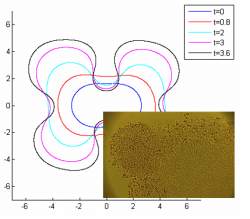 Two professors from the Department of Computing and Numerical Analysis at the University of Cordoba, Carmen Calzada and Mercedes Marín, have developed, with the collaboration of Enrique Fernández-Cara and Gema Camacho, from the University of Seville, a resolution method for a mathematic model capable of predicting the evolution of a tumour in the avascular phase, when the only nutrients that reach the tumorous cells come from the adjacent tissues, and in the vascular phase, when a network of capillaries that reach the tumour have already been created, contributing a large quantity of nutrients and making it grow rapidly.
Two professors from the Department of Computing and Numerical Analysis at the University of Cordoba, Carmen Calzada and Mercedes Marín, have developed, with the collaboration of Enrique Fernández-Cara and Gema Camacho, from the University of Seville, a resolution method for a mathematic model capable of predicting the evolution of a tumour in the avascular phase, when the only nutrients that reach the tumorous cells come from the adjacent tissues, and in the vascular phase, when a network of capillaries that reach the tumour have already been created, contributing a large quantity of nutrients and making it grow rapidly.
This research team has solved the model by employing numerical techniques based on level set and fictitious domain methods that have been used successfully for some time in other problems of different origin, such as the sedimentation of particles in a fluid.
These results, published in the Journal of Computational Physics, are another step forwards in cancer patients’ fight for survival. Although the study is still in its preliminary phase, the team is already working on the incorporation into the model of the variables and relations that simulate the administration of a therapy. The objective is to set out and resolve a problem of optimal control that allows the simulation of different administration protocols depending on the type of tumour, with the objective of helping in the decision-making process.
Mathematic models and computer simulations are being used more and more in medicine to describe and understand the workings of living beings and their diseases. In this way, in vitro experimentation in the laboratory, or in vivo experimentation with living beings, has been part of the type of experimentation called in silico, carried out by computer, for some time.
Jueves, 22 Diciembre 2016 16:58
A mathematic model is developed to predict tumour growth.
Escrito porThe result of the investigation was published in the Journal of Computational Physics.
Publicado en
Biomedicina y salud

